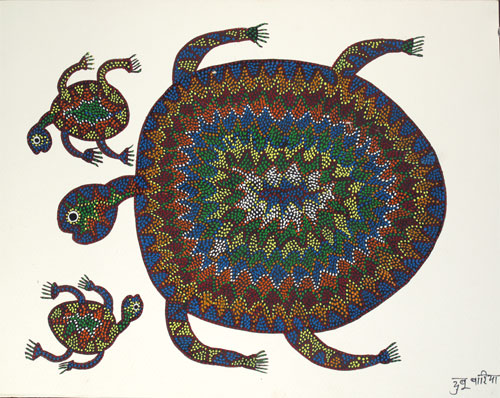The Bhasha Research and Publication Centre was founded in 1996 to study, document and conserve India's non-scheduled languages. ‘Bhasha’ stands for the ‘voice’ of the tribals, and has over the years emerged as an institution with the active involvement of tribal society, making possible meaningful and sustainable interventions. The major activities of Bhasha include the documentation and conservation of languages, study and promotion of tribal arts, research, education, healthcare, and policy-level interventions in the interest of tribal development. Rather than address the issues faced by tribal communities separately, Bhasha views tribal development in a holistic manner, in which tribal culture provides a significant understanding to the problems of healthcare, education and development. Bhasha Chas established the Adivasi Academy at Tejgadh, Gujarat. Bhasha has done pioneering work in documenting the tribal music of six Indian states, and an ethnography of 70 Gujarati communities.
Under the leadership of Dr. Ganesh Devy, Bhasha recently completed, the People"s Linguistic Survey of India, documenting 780 languages.
ICF spoke to Prof Kanji Patel, writer and honorary director of the Adivasi Academy, about the Centre's activities.

Would you give us an idea of the ways in which people from the tribal communities are directly involved in your projects?
Bhasha and Adivasi Academy’s network in Adivasi communities is strong in 1200 tribal villages in Gujarat, and in the bordering areas of Madhya Pradesh, Maharashtra and Rajasthan. The organisation has worked in the fields of art, culture, languages, development, health and education. Trained Adivasi youth take the initiatives to Adivasi communities. The youth discuss, decide and devise ways in regard to the what, why, how, where and when of the projects. The educated first generation of the tribal communities are the stakeholders in all initiatives. Through the spirit and action of the projects we take care that the Adivasis are understood sensitively.
Please take us through one or two examples of the documentation process of tribal arts. How exactly does this work on the ground? For example, who chooses the art, who are the resource people for information etc?
After, surveying the tribal languages, our Adivasi colleagues thought of writing ethnographs on tribal communities. They prepared a comprehensive questionnaire that would go into making these ethnographs. It was called the ‘Tejgadh method’ of insiders’ ethnography. The primary drafts in Gujarati were discussed among them and final drafts were read out before the community. A selected ethnography has been uploaded to our website,
www.bhashaebooks.org.
Please give us an idea of the range of tribal languages and their state of survival?
Take the example of the tribal languages of Gujarat. The range of tribal languages is wide. It covers 20 to 22 percent of the state's population. There are 24 tribal languages, 11 languages of the Denotified and Nomadic Tribes, 5 coastal languages. The state of survival of these languages is grim as the children of these communities do not yet have access to primary education. The endangered tribal languages are Airani, Kathodi, Gorpa, Mangeli, Kolgha. Chamthi, Thori, Nayaki, Bahurupi, Madari, Mir-Mirasi, Vanjari, Vadi, Sandhi, Dafer are languages of the Denotified and nomadic communities. The stigma of "born criminal tribes" from the colonial administration on has ensured the death of languages of denotified and nomadic tribes. The Sidi language (of Swahili origin) is already dead.


